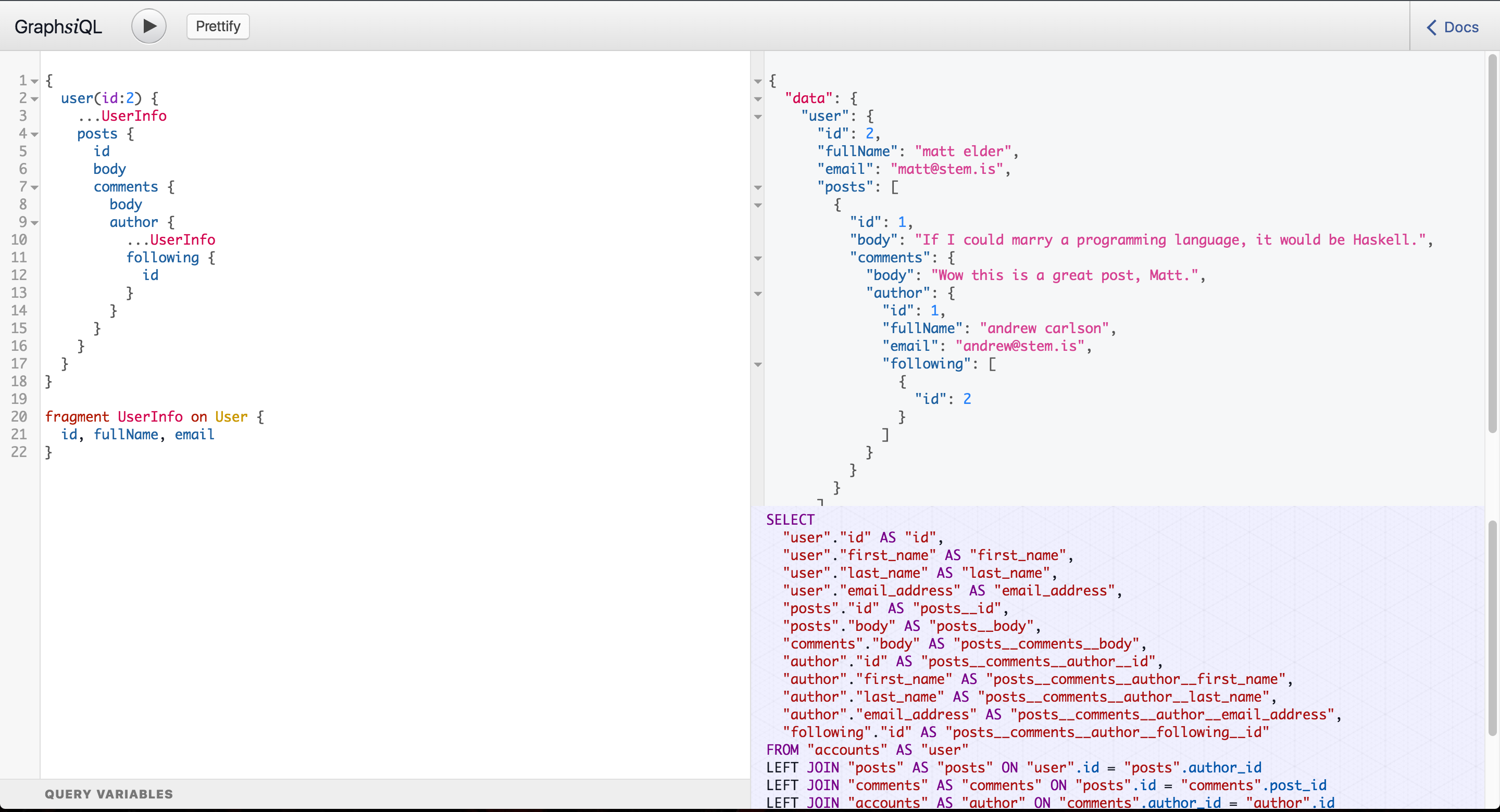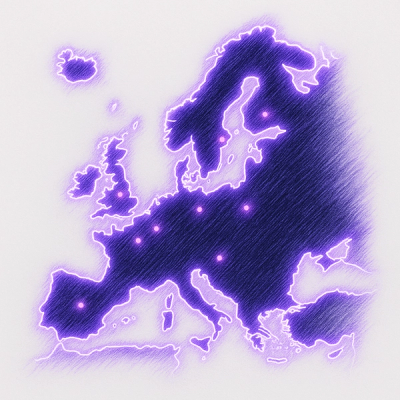



Query Planning and Batch Data Fetching between GraphQL and SQL.
What is Join Monster?
Efficient query planning and data fetching for SQL.
Use JOINs and/or batched requests to retrieve all your data.
It takes a GraphQL query and your schema and automatically generates the SQL.
Send that SQL to your database and get back all the data needed to resolve with only one or a few round-trips to the database.
Translate a GraphQL query like this:
{
user(id: 2) {
fullName
email
posts {
id
body
comments {
body
author { fullName }
}
}
}
}
...into a couple SQL queries like this:
SELECT
"user"."id" AS "id",
"user"."email_address" AS "email_address",
"posts"."id" AS "posts__id",
"posts"."body" AS "posts__body",
"user"."first_name" AS "first_name",
"user"."last_name" AS "last_name"
FROM accounts AS "user"
LEFT JOIN posts AS "posts" ON "user".id = "posts".author_id
WHERE "user".id = 2
SELECT
"comments"."id" AS "id",
"comments"."body" AS "body",
"author"."id" AS "author__id",
"author"."first_name" AS "author__first_name",
"author"."last_name" AS "author__last_name",
"comments"."post_id" AS "post_id"
FROM comments AS "comments"
LEFT JOIN accounts AS "author" ON "comments".author_id = "author".id
WHERE "comments".archived = FALSE AND "comments"."post_id" IN (2,8,11,12)
...and get back correctly hydrated data.
{
"user": {
"fullName": "Yasmine Rolfson",
"email": "Earl.Koss41@yahoo.com",
"posts": [
{
"id": 2,
"body": "Harum unde maiores est quasi totam consequuntur. Necessitatibus doloribus ut totam dolore omnis quos error eos. Rem nostrum assumenda eius veniam fugit dicta in consequuntur. Ut porro dolorem aliquid qui magnam a.",
"comments": [
{
"body": "The AI driver is down, program the multi-byte sensor so we can parse the SAS bandwidth!",
"author": { "fullName": "Yasmine Rolfson" }
},
{
"body": "Try to program the SMS transmitter, maybe it will synthesize the optical firewall!",
"author": { "fullName": "Ole Barrows" }
},
]
},
]
}
}
It works on top of Facebook's graphql-js reference implementation.
All you have to do is add a few properties to the objects in your schema and call the joinMonster function.
A SQL query is "compiled" for you to send to the DBMS.
The data-fetching is efficently batched.
The data is then hydrated into the right shape for your GraphQL schema.
Why?
More details on the "round-trip" (a.k.a. N+1) problem are here.
Since it works with the reference implementation, the API is all very familiar. Join Monster is a tool built on top to add batch data fetching. You add some special properties along-side the schema definition that Join Monster knows to look for. The use of graphql-js does not change. You still define your types the same way. You can write resolve functions to mainpulate the data from Join Monster, or incorporate data from elsewhere without breaking out of your "join-monsterized" schema.
Join Monster has support for several different implementations of pagination, all based on the interface in the Relay Connection Specification. Using Relay on the client is totally optional!
Works with the RelayJS
Great helpers for the Node Interface and automatic pagination for Connection Types. See docs.
Usage with GraphQL
$ npm install join-monster
- Take your
GraphQLObjectType from graphql-js and add the SQL table name.
- Do the fields need values from some SQL columns? Computed columns? Add some additional properties like
sqlColumn, sqlDeps, or sqlExpr to the fields. Join Monster will look at these when analyzing the query.
- Got some relations? Write a function that tells Join Monster how to
JOIN your tables and it will hydrate hierarchies of data.
- Resolve any type (and all its descendants) by calling
joinMonster in its resolver. All it needs is the resolveInfo and a callback to send the (one) SQL query to the database. Voila! All your data is returned to the resolver.
import joinMonster from 'join-monster'
import {
GraphQLObjectType,
GraphQLList,
GraphQLString,
GraphQLInt
} from 'graphql'
const User = new GraphQLObjectType({
name: 'User',
sqlTable: 'accounts',
uniqueKey: 'id',
fields: () => ({
id: {
type: GraphQLInt
},
email: {
type: GraphQLString,
sqlColumn: 'email_address'
},
idEncoded: {
description: 'The ID base-64 encoded',
type: GraphQLString,
sqlColumn: 'id',
resolve: user => toBase64(user.idEncoded)
},
fullName: {
description: "A user's first and last name",
type: GraphQLString,
sqlDeps: [ 'first_name', 'last_name' ],
resolve: user => `${user.first_name} ${user.last_name}`
},
capitalizedLastName: {
type: GraphQLString,
sqlExpr: (table, args) => `UPPER(${table}.last_name)`
},
posts: {
description: "A List of posts this user has written.",
type: new GraphQLList(Post),
sqlJoin(userTable, postTable) {
return `${userTable}.id = ${postTable}.author_id`
}
},
comments: {
description: "The comment they have written",
type: new GraphQLList(Comment),
sqlBatch: {
thisKey: 'author_id',
parentKey: 'id'
}
},
following: {
description: "Other users that this user is following.",
type: new GraphQLList(User),
junction: {
sqlTable: 'relationships',
sqlJoins: [
(followerTable, junctionTable, args) => `${followerTable}.id = ${junctionTable}.follower_id`,
(junctionTable, followeeTable, args) => `${junctionTable}.followee_id = ${followeeTable}.id`
]
}
},
numLegs: {
description: 'Number of legs this user has.',
type: GraphQLInt,
resolve: () => 2
}
})
})
const Comment = new GraphQLObjectType({
name: 'Comment',
sqlTable: 'comments',
uniqueKey: 'id',
fields: () => ({
id: {
type: GraphQLInt
},
body: {
type: GraphQLString
}
})
})
const Post = new GraphQLObjectType({
name: 'Post',
sqlTable: 'posts',
uniqueKey: 'id',
fields: () => ({
id: {
type: GraphQLInt
},
body: {
type: GraphQLString
}
})
})
export const QueryRoot = new GraphQLObjectType({
name: 'Query',
fields: () => ({
user: {
type: User,
args: {
id: { type: GraphQLInt }
},
where: (usersTable, args, context) => {
if (args.id) return `${usersTable}.id = ${args.id}`
},
resolve: (parent, args, context, resolveInfo) => {
return joinMonster(resolveInfo, {}, sql => {
return knex.raw(sql)
})
}
}
})
})
Detailed instructions for set up are found in the docs.
Using with graphql-tools
The GraphQL schema language doesn't let you add arbitrary properties to the type definitions. If you're using something like the Apollo graphql-tools package to write your code with the schema language, you'll need an adapter. See the join-monster-graphql-tools-adapter if you want to use this with graphql-tools.
Running the Demo
$ git clone https://github.com/stems/join-monster-demo.git
$ cd join-monster-demo
$ npm install
$ npm start
# go to http://localhost:3000/graphql
# if you also want to run the paginated version, create postgres database from the dump provided
psql $YOUR_DATABASE < data/paginated-demo-dump.sql
DATABASE_URL=postgres://$USER:$PASS@$HOST/$YOUR_DATABASE npm start
# go to http://localhost:3000/graphql-relay
Explore the schema, try out some queries, and see what the resulting SQL queries and responses look like in our custom version of GraphiQL!

There's still a lot of work to do. Please feel free to fork and submit a Pull Request!
Future Work





